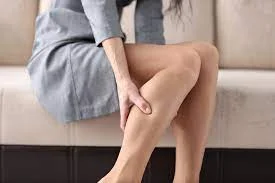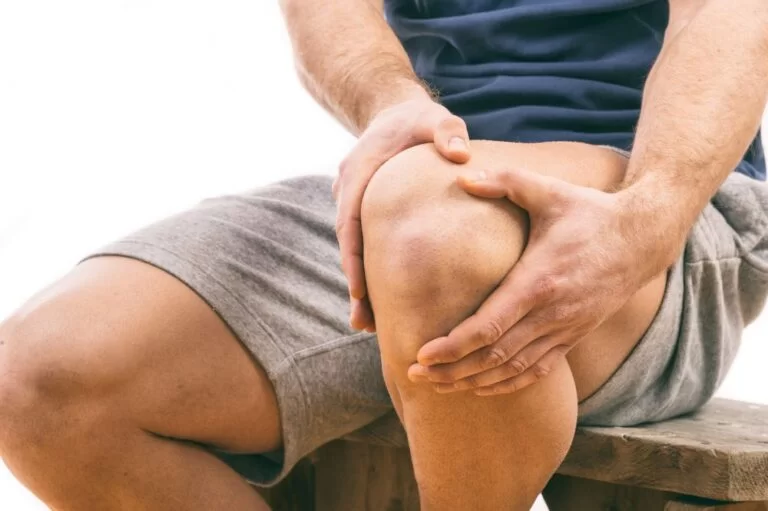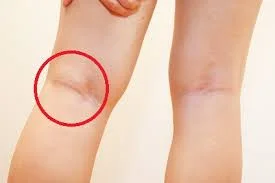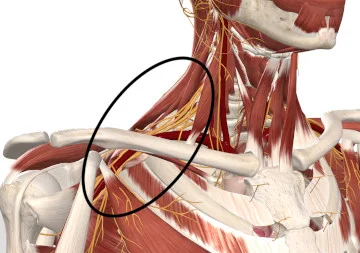How to Reduce Nerve Pain In Leg
Introduction
Nerve pain in the leg, medically known as neuropathy, can range from a mild disturbance to a debilitating condition, significantly impacting your daily life. To understand this complex issue, let’s dive into its introduction:
Nerve pain: What is it?
Nerve pain in the leg refers to pain, tingling, numbness, or other abnormal sensations originating from damaged or dysfunctional nerves in the leg. It can affect any part of the leg, from the foot to the thigh, and manifest in various ways.
Mechanical or chemical irritants can cause the leg’s nerves to inflame, compress, or degenerate. Additionally, related disorders like diabetes or dietary deficiencies can harm nerves. Leg symptoms may vary depending on the source of nerve damage.
Sharp, shooting, electric-like, or searing pain are common descriptions of nerve pain. Additionally, it might feel like warm or hot water is streaming down your leg or thigh. Some people may experience a dull ache. The pain could come on and off or be constant.
Types of nerve pain:
Neuropathy, another name for nerve pain, can have some origins and presentation patterns. Typical varieties include some of the following:
- Peripheral neuropathy: Usually resulting in burning, tingling, or numbness, this condition affects the nerves of the hands and feet.
- Sciatica: This pain originates from inflammation of the sciatic nerve and radiates down the back of the leg.
- Diabetic neuropathy is a frequent side effect of diabetes that affects nerves all over the body, including the legs.
Cause of Nerve Pain In Leg
It might surprise you to hear that the spine is frequently the source of nerve pain in the legs. Specifically, the spinal cord—the primary superhighway that connects your body and brain—is located in your spinal column. Here, nerve roots leave the body through holes in the vertebrae to form a vast network that innervates our extremities and enables us to operate normally.
Your spine, however, may be compromised by age or injury. As a result, the surrounding anatomy may irritate or even compress your nerves.
More specifically, a few of the more typical reasons for nerve pain in the lower body include
- Sciatica
The most typical type of nerve pain that affects the legs is sciatica. But be advised: sciatica is not a real illness. Rather, it is a term used by medical professionals to characterize pain that arises from pinched, irritated, or inflamed sciatic nerves.
The longest and biggest nerve in the body is the sciatic nerve. It emerges through the pelvis after beginning in the lumbar spine of the lower back. The sciatic nerve then splits off to allow sensation and movement throughout the lower body, passing through the leg and the hip joint.
Why does sciatica occur?
Causes of Sciatica are:
- Herniated lumbar discs: As you age or sustain an injury, the rubbery cushions between each vertebra, called intervertebral discs, may burst, putting pressure on the nerves that surround them and the legs’ sensory organs.
- Degenerative disc disease: As we get older, the intervertebral discs may dry out and lose their structure. Disc herniation and a variety of other issues, including lumbar radiculopathy, may result from this.
- Spinal stenosis: As we age and develop arthritis, the passageways that allow nerves to leave the spinal cord can narrow. Nerve impingement may result from this.
- Bone spurs: An excessive growth of bone on a lumbar vertebra may result from osteoarthritis. The sciatic or lumbar nerves may be directly compressed by these bony protrusions.
- Spondylolisthesis or spondylolysis: The spine’s structural integrity may be affected by the vertebrae slipping or cracking, which can cause pain from pinched nerves in the legs.
- Piriformis syndrome: Overuse or underuse of this large muscle close to the sciatic nerve can cause it to tighten and compress the nerve.
Many different things can cause nerve pain in the leg, from common illnesses to more serious underlying problems. It’s important to understand that while I am not qualified to diagnose illnesses, I can offer some broad insights into possible causes of your leg pain:
Causes related to the musculoskeletal system:
- Sciatica: Lower back sciatic nerve compression, frequently brought on by bone spurs or herniated discs. Pain travels down the leg and buttocks.
- Pinched nerves: Tight surrounding tissues can pinch other nerves in the leg, resulting in tingling and pain.
- Spinal stenosis: Pain, numbness, and weakness are caused by pressure on nerves caused by a narrowing of the spinal canal.
- Osteoarthritis: When joint cartilage deteriorates, pain can be felt by irritated nerves.
Nutritional and metabolic:
- Diabetes: Excessive blood sugar levels over an extended period can harm nerves in the body, including the legs. We refer to this as diabetic neuropathy.
- Vitamin deficiencies: Nerve pain may result from B vitamin deficiencies, particularly those involving B12.
- Alcoholism: Drinking too much alcohol can cause nerve damage.
- infections
- Shingles: This painful rash with blisters is caused by a viral infection that affects the nerves.
- Lyme disease: Bacterial infection carried by ticks that can harm nerves and result in pain, weakness, and other symptoms.
Additional reasons
- Autoimmune diseases: Rheumatoid arthritis and lupus are two examples of illnesses that can attack nerves and cause pain.
- Toxins: Nerve damage can result from exposure to some toxins, such as heavy metals.
- Trauma: Leg injuries can harm nerves, resulting in discomfort, numbness, and weakness.
Alternative Sources of Leg Pinched Nerve Pain
But one type of nerve damage that might be causing your symptoms is sciatic nerve injury or damage. The following conditions also cause symptoms in the legs:
- Peripheral neuropathy: Typically caused by diabetes, this illness is characterized by damage to the peripheral nervous system, which includes the nerves that provide feeling to the legs and feet.
- Peroneal Neuropathy: Impairments to the knee or hip can compress the peroneal nerve, which is situated close to the knee.
- Lumbosacral Radiculoplexus Neuropathy: To remain healthy, your nerves need blood flow. Small blood vessels in the legs can be damaged by diabetes or inflammation, which lowers the blood supply to the nerve and results in dysfunction.
The phrase “nerve pain that originates directly from spinal nerves and affects the legs” refers to a condition known as neurogenic claudication. Neurogenic claudication patients frequently report feeling as though their legs are lead weights or have trouble walking.
Compression of a cluster of nerves extending from the lower back’s spinal cord to the legs and bladder is known as cauda equina syndrome. This syndrome typically results in loss of control over one’s bowels or bladder, and it requires prompt medical attention to prevent permanent paralysis of the legs.
Some causes in details for nerve pain
- Radiculopathy
Radiculopathy is the medical term for leg pain that results from an issue with the lumbar and/or sacral spine’s nerve roots (the lay term is sciatica). Inflammation, irritation, or compression of the nerve roots may be the cause of this pain. 1. The particular nerve root or nerve roots that are affected determine the features of this pain.
95% of lumbosacral spine radiculopathy happens at the L4-L5 and L5-S1 levels. Two factors describe the pain originating from these nerve roots:
- pain that radiates down the leg, foot, and buttocks from the lower back or buttocks.
- tingling in the toes, foot, or calf.
- weakness in the muscles of the thighs, hips, and/or feet.
Additional sensations, such as a feeling of pins and needles in the leg, warm water running down the thigh, or the foot submerged in hot water, may manifest depending on the individual. Usually, radiculopathy affects just one leg.
2. The peripheral neuropathy
Peripheral neuropathy is the term for injury to one or more nerves in the peripheral nervous system, which is separate from the brain and spinal cord. Diabetes is the most common cause of this type of neuropathy that affects the legs. Often, diabetic peripheral neuropathy results in:
- The term “stocking-glove pattern” refers to the pain that starts in the toes and gradually moves toward the knee when wearing stockings.
- tingling in the feet and legs
- In the later stages of the illness, weakness in the ankles and toes
- Pain from peripheral neuropathy usually affects both legs.
3. Neuropathy of the Lumbosacral Radiculoplexus
This disorder is brought on by inflammation of the small blood vessels in the legs, which reduces the flow of blood to the nerves and damages them. Diabetics frequently experience this condition, which can also be brought on by other problems. Typical symptoms consist of 5:
- Pain that typically starts in one area of the leg and gradually spreads to other areas, such as the foot, leg, hip, or buttock
- Prickling sensation and numbness in the afflicted areas
- weakened muscles in the legs
- imbalance loss, which could result in falls
- Usually, multiple nerves are impacted simultaneously. The illness may start in one leg and eventually spread to the other leg.
4. Peroneal Neuropathy
Leg symptoms could result from compression of the peroneal nerve close to the knee. Common signs and symptoms consist of:
- Foot drop is a condition marked by a catch in the toes or an inability to raise the foot while walking.
- numbness in the first toe web space, the upper portion of the foot, and/or the side of the leg.
- Although pain is not a common aspect of this illness, it might be felt if trauma causes peroneal neuropathy.
5. The Paresthetic Meralgia
Meralgia paresthetica is a condition that can result from compression of the lateral femoral cutaneous nerve in the thigh. Typical symptoms include:
- painful or burning pain on the front, outside, or both of the thigh
- The affected areas are cold.
- Thigh-area buzzing or vibrations (like those from a cell phone)
- The pain associated with meralgia paresthetica usually gets worse when standing or walking and gets better when sitting.
6. Tarsal Tunnel Syndrome
This syndrome is brought on by tibial nerve dysfunction brought on by nerve compression inside the tarsal tunnel of the foot. symptoms of :
- A sharp, shooting pain along the sole and in the inner ankle joint
- Tingling in the foot’s sole
- Burning or tingling feeling in the foot
- Usually, the symptoms get better with rest and get worse at night, with walking or standing, and/or after physical activity.
7. Neurogenic Claudication
This kind of leg pain is brought on by spinal stenosis, a narrowing of the spinal canal that compresses the spinal cord. The causes of this compression could be spondylolisthesis (forward slippage of a vertebra), lumbar disc herniation, or bone spurs (abnormal bone growth).
Neurogenic claudication usually affects both legs, presenting with the following symptoms:
- Numbness and pain when standing, walking, or doing exercises in an upright position.
- Weakness when moving the legs.
- When the spine is bent backward, neurogenic claudication pain usually gets worse; when the spine is bent forward at the waist, sitting, or lying down, it usually gets better.
Based on the specific symptoms that are present, the patient’s medical history, and the results of certain clinical tests, a trained medical professional can assist in determining the exact root cause of leg nerve pain.
Symptoms of nerve pain in the leg
Many symptoms can be caused by nerve problems; these include shooting, stabbing, burning, aching, or electric shock sensations. Mild symptoms could be the result of a normal pain signal being sent by an irritated nerve. However, a compressed or pinched nerve is the cause of more severe symptoms. The following are some instances of mild vs. more severe symptoms:
- Moderate Signs and Symptoms
- Needles and pins
- Increased sensitivity,
- Burning pain, and more severe symptoms
- Deficiency
- Numbness
- Paraesthesia
- Poor reflexes
Compression of a nerve can result in symptoms that are not limited to the site of damage. As you now know, there are several possible causes of nerve pain in the leg. Having said that, many nerve injuries present with comparable symptoms.
Common signs and symptoms consist of:
- Pain: Including lower body pain that radiates, burns, shoots, or is “electrical.”
- Pain following specific activities: Prolonged standing or sitting, walking, stair climbing, and getting out of a chair are all activities that can exacerbate pain.
- Loss of feeling in the calf, foot, toes, and/or leg muscles is referred to as numbness or tingling.
- Weakness: Reduced strength in the thigh, foot, hip, leg, or toe muscles.
- Foot drop: Also referred to as difficulty lifting the foot.
- Feeling dizzy: Experiencing unsteadiness and an increased risk of falling.
- Getting a proper diagnosis is crucial before beginning any new treatments because symptoms alone might not be able to identify the source of your pain.
Depending on the underlying cause and affected nerves, leg nerve pain can present itself in some ways. The following are some typical symptoms to be aware of:
Pain:
- Burning, stabbing, or sharp pain
- A throbbing or aching pain
- Dull, ongoing discomfort
- Pain that gets worse at night or when doing specific things
Sensory changes:
- Sensitivity or tingling
- Sensations of needles and pins
- Feeling as though you’re wearing gloves or socks when you’re not Hypersensitivity to touch
Weakness and issues with equilibrium:
- Having trouble standing or walking
- Weakness or wasting of the muscles
- Stumbling or being clumsy
Other signs and symptoms
- Variations in the skin, like redness, sweating, or dryness
- Hair loss on the impacted limb
- Inability to regulate bowel or bladder function
Identifying Leg Nerve Pain Diagnosis
Determining the exact root cause of nerve pain is one of the best ways to relieve it. Many nerve conditions have similar symptoms. You can take more proactive measures to relieve your pain if you are aware of the precise cause of your discomfort.
However, how can you determine the source of your leg pain?
For most people, the first step in this process is to visit your physician or spine care specialist.
Your physician will review your medical history with you during a consultation. This covers the following:
- When the pain first started
- What was happening before your discomfort
- What other symptoms you’re experiencing are similar to how your pain feels
- What causes your symptoms to worsen or improve?
- Your current medical conditions
- Any related physical traumas or injuries
- Your way of life and methods of employment
- Your family’s medical history
What medications or supplements are you currently taking?
Following the collection of your medical history, your doctor will conduct an in-depth physical examination. Your physician will examine you to determine whether you are experiencing any lower body pain in the back, buttocks, thigh, leg, etc. Your doctor will also perform some quick tests to check for any swelling, skin abnormalities, muscle weakness, or reflex activity.
Your doctor will have a better understanding of your leg pain after your initial consultation. Having said that, a few more examinations and diagnostic procedures might be required to reach an accurate diagnosis.
MRIs, CT scans, and X-rays are examples of diagnostic imaging that can be used to confirm or exclude specific conditions. Imaging tests are particularly helpful in the detection of bone spurs, herniated discs, tumors, and fractures in the spine.
Your doctor might also prescribe a nerve block for diagnostic purposes. An anesthetic solution is injected close to the suspected nerve during this test. After a nerve block, if your symptoms improve, it can help identify the source of your pain.
Another useful tool in the diagnostic process could be a myelogram. During a myelogram procedure, a radiologist uses a special dye to see whether your spinal cord, nerve roots, or nerves are being compressed by anything. This can involve a slipped vertebra or ruptured discs.
How to Treat Nerve Pain
Your nerve pain treatment team can begin offering conservative pain management strategies as soon as an accurate diagnosis has been made. Non-surgical methods are frequently advised unless your symptoms are severe or putting you in immediate danger, as in the case of cauda equina syndrome.
Here are some self-care measures for nerve pain relief that you can do (with a doctor’s approval).
- Stretch
Easy stretches can help increase your spinal flexibility and range of motion. You can strengthen your core by incorporating stretching into your daily routine. Consult a physical therapist or your doctor about the stretches that might be most appropriate for your condition.
2. Exercise
When you are in pain, exercising might seem impossible. However, you can reduce your symptoms by moving around. Naturally, you don’t want to go overboard. Put an end to your marathon and heavyweight training. But you can strengthen your core, supporting muscles, and spine by engaging in a small amount of low-impact exercise each day. Exercise also releases endorphins, which are the body’s natural analgesics.
3. Make Enough Sleep
While you sleep, your body repairs itself. It is recommended to try to get 7 to 8 hours of good sleep every night if you are suffering from nerve pain. Additionally, choose a sleeping position that avoids the affected nerve from needless pressure.
4. Pay Attention to Your Posture
Maintaining proper posture relieves pressure on the spine and improves its health. Your posture is impacted by spending a lot of time hunched over a desk or staring at electronics. Consult a physical therapist or your doctor about good posture practices.
5. Apply Ice and Heat Therapy
Painful symptoms can be relieved by switching between an ice pack and a heating pad. Applying ice, for instance, helps to reduce inflammation. Conversely, heat facilitates blood circulation and fosters the healing process. Try applying an ice pack once every hour for at least 15 minutes when you’re in pain. Next, every two to three hours, apply a heating pad for 15 minutes. Use a barrier between the hot and cold packs to protect your skin.
6. Physical Therapy
A physical therapist can offer explanations for your pain, such as weak core muscles or bad posture. Your physical therapist will design a regimen that incorporates target exercises, aerobic training, and stretching.
7. Alternative Therapies
Holistic methods such as yoga, massage, or acupuncture have been successful in treating some lumbar nerve pain sufferers. Is a pinched nerve suitable for chiropractic care? Indeed! For instance, a certified chiropractor’s manipulation of the spine may be a successful non-invasive treatment.
Many of the symptoms of nerve pain eventually go away on their own with patience and appropriate care. It might be time to see a specialist for more extensive treatment options if you’ve tried these conservative treatments and are still not feeling better.
Identify the Cause of Your Nerve Pain and Create a Treatment Plan for It.
Excelsia Injury Care is committed to promoting your recovery. With their combined education and experience, our diverse team can accurately diagnose your nerve pain problems. Following a correct diagnosis, we will create a personalized treatment plan based on your unique requirements and way of life.
The majority of spine conditions can be treated without surgery, as you may have heard. Our team of experts in conservative treatment, which includes chiropractors, physical therapists, pain management specialists, and rehab doctors, is prepared to assist you in getting back to the activities you enjoy.
At-home solutions
Pain management typically entails combining some strategies, such as home remedies and prescription drugs. The following medical procedures could help with pain relief:
A warm bath or compress
An excess of heat might aggravate MS symptoms, says nutrition consultant Barbara Rodgers. A hot compress or bath could exacerbate the situation. Warm compresses, however, can offer comfort and relief.
Massage
A massage can be used to promote relaxation and a feeling of well-being, as well as to stimulate blood flow in the body and gently relieve tense and painful muscles. This kind of calm is important yet frequently difficult for MS patients.
Therapy
People with MS may report discomfort more frequently if they are experiencing stress, despair, or anxiety, according to the U.S. Department of Veterans Affairs. The discomfort that these pressures and psychological problems once aggravated can be reduced by managing them. Joining support groups and seeing a therapist are two ways to reduce these psychological factors.
Diet for Nerve pain
Given its ability to promote nerve health and reduce inflammation, diet can be an important factor in the management of leg nerve pain. Here are some important nutritional guidelines to think about:
Make anti-inflammatory foods a priority:
- Fruits and vegetables: Packed with vitamins and antioxidants, these foods reduce inflammation and support healthy neuron function. Excellent options include citrus fruits, root vegetables, berries, and leafy greens.
- Omega-3 fatty acids: Essential for reducing inflammation and supporting nerve function, omega-3s can be found in walnuts, flaxseeds, chia seeds, and fatty seafood including salmon, tuna, sardines, and mackerel.
- Complete grains: Select whole grains rather than refined ones, such as barley, quinoa, brown rice, and oats. Rich in fiber and B vitamins, whole grains are necessary for the functioning of your nerves.
Minimize inflammatory triggers:
- Processed foods: Steer clear of sugar-filled beverages, processed foods, and harmful fats including trans and saturated fats. These increase nerve discomfort and add to inflammation.
- Red meat and poultry: Limit your intake of these foods. Choose lean meats and concentrate on other sources of protein, such as fish, lentils, and beans.
- Refined carbs, such as white rice, bread, and pastries, should be avoided. These raise inflammation and result in blood sugar increases.
- Limit your intake of alcohol and caffeine because they can make nerve discomfort worse and make it harder to fall asleep.
Extra food advice:
- Remain hydrated: Throughout the day, sip on lots of water to maintain the health of your body and nerves.
- Increase your intake of vitamins B12, B6, and B1, as they may be good for the health of your nerves. In case you are deficient, think about taking supplements.
- Be careful when using spices: some, like garlic, ginger, and turmeric, have anti-inflammatory qualities and may be useful in the treatment of pain.
- Speak with a dietitian: See a certified nutritionist for individualized dietary advice and therapy for particular nerve pain issues.
Dietary supplements
Several deficiencies can both induce and increase nerve discomfort. Your physician can assist you in assessing whether you could be lacking in:
- Zinc
- Vitamin B-12
- Vitamin B-1
- Vitamin B-6
- Vitamin D
- Vitamin E
Dietary changes
A bad diet is often linked to pain and illness. When it comes to nerve discomfort, Rodgers advises MS patients to examine their diet closely and think about removing common causes. Corn, dairy, gluten, soy, and sugar are a few possible ones.
Physiotherapy treatment for nerve pain in the leg
Your physiotherapist will first identify the underlying cause of the issue as there are numerous reasons for nerve pain. Your physiotherapist will evaluate your symptoms to identify the source of your nerve issue.
To identify the origin and severity of your disease, an in-depth evaluation and examination, including a review of your medical history, will take place before treatment. To assess the extent of the injury, further testing such as an MRI, CT scan, or X-ray may be recommended.
One popular kind of treatment for nerve pain is physiotherapy, which aims to maximize range of motion, minimize discomfort, and reduce pain. Nerve physiotherapy effectively relieves pain caused by irritation or compression of the nerves. Expect the following physical therapy treatments, contingent on the affected body part:
Spinal mobilization: This therapy aims to improve the neural tissue’s flexibility and mobility by manually moving or, in specific circumstances, manipulating the spinal joints. The procedure involves releasing restrictive joints and muscles that are restricting movement and pressing on nerves. To relieve a patient’s symptoms, this type of treatment frequently has a desensitizing effect on the nearby brain tissue.
Dry needling: Thin acupuncture needles are inserted into the appropriate muscles during a technique called “dry needling.” With this treatment, muscle tension can be reduced and normal muscle function and range of motion can be regained. Dry needling is an effective instrument for treating certain nerve-related conditions and relieving pain.
Massage therapy: One of the most well-known methods for treating nervous system problems and managing pain is massage therapy. In addition to improving flexibility and general mobility, specific pressure applied to soft tissue and muscles along with a combination of techniques including kneading, friction, compression, and vibration can all effectively relieve the immediate symptoms of nerve pain.
Exercises for joints, muscles, ligaments, and tendons: Targeted, regulated routines of exercise that maximize muscle function can be the most effective form of physical therapy for leg nerve pain. Consult your physiotherapist about creating an exercise regimen that combines pain management and conditioning.
Stretching: Any daily treatment plan for nerve pain, particularly in the legs, should include stretching in addition to exercise. Stretching after exercise is important because it allows the muscles to warm up before adding pressure or stretching, which makes greater stress positions far more effective.
Education to minimize pressure and irritation: Physiotherapy tries to educate and modify specific lifestyle habits that might be contributing to the source of pain to reduce pressure and irritation. Cutting back on alcohol or caffeine use is one example of a lifestyle modification that could be contributing to or aggravating nerve pain sensations.
Options for Treating Severe Nerve Pain in the Legs
Surgery may be required in severe cases of nerve pain to fully resolve the problem. Surgery is typically the last option on the list of therapies, but it can be useful if other approaches aren’t working. Surgery is a difficult decision to make no matter what. It usually entails a higher level of risk and is done under the guidance and consultation of a medical practitioner. Surgery for serious nerve injury in the leg should be performed after taking into account potential changes to other parts of the patient’s lifestyle.
The decision to make is constantly affected by some factors, including cost. Recall that not every pain is equal to tissue damage, so you should always carefully assess your options for therapy and speak with a medical expert or physiotherapist before making a decision. Knowing what’s causing your pain will help you make the best choice possible.
Exercise to reduce nerve pain in the leg
Resisted- Band-Calf-Exercises
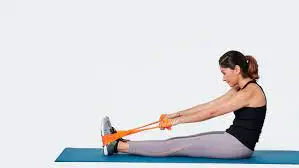
how to do it:
- Resistance Band Seated Calf Stretch
- Sit with your legs outstretched on the floor.
- Wrap a resistance band (or other tool) around one foot, gripping both sides with your hands.
- Pull your toes gently towards your shin until you feel a stretch in your calf.
- Rep on the opposite side.
Advantages of calf stretch for nerve pain
- Increased blood flow: Stretching can help your legs’ muscles and nerves receive more blood, which may assist with reducing pain and inflammation.
- Improved flexibility: Pain might result from tight calf muscles pressing on your legs’ nerves. You can relieve pressure on your calf muscles and nerves by stretching.
- Decreased muscular tension: Nerve discomfort can also be caused by reduced muscle tension. Stretching may reduce stress and help your calf muscles relax.
The Single Knee-To-Chest Stretch
The hip and lower back muscles are the focus of this stretch. By producing gapping for the nerves exiting the lower spine, this lowers pressure on the spinal nerves.
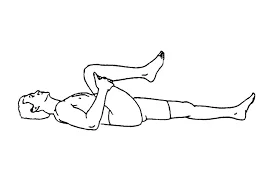
How to do it:
- To do this stretch, simply lie on your back, grasp your knee, and slowly stretch it toward your chest.
- Hold your leg there for 20 seconds, then repeat three times.
- Bring both legs up to your chest if it feels less painful.
The Towel Hamstring Stretch
This stretch accomplishes two things. For starters, it improves hamstring flexibility while also improving hip range of motion. This makes daily chores simpler to do and reduces the strain of bending over.
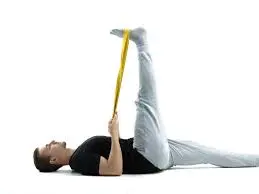
how to do it
- Simply lie on your back, tie a towel or a strap under your foot, and draw up your leg until a stretch is felt down the rear of your leg while maintaining your leg straight.
- Hold your leg there for 30 seconds, then repeat twice more.
- Try to do this twice a day.
The Advantages of Hamstring Exercises
- An important component in posture and lower back discomfort is the hamstrings. They regulate how your pelvis and legs move.
- The pelvis is made up of two hip bones that support your spine. The lumbar spine and pelvis move in together. A posterior pelvic tilt can result from hamstring contractions. This is the tailbone tilting downward towards the rear of the thigh.
- The hamstrings and hip muscles adjust and occasionally realign the pelvis. Lower back pain is exacerbated by hamstring tightness. The natural arch of your lower back is flattened and persistently contracted hamstrings pull the pelvis. This may weaken and overstretch muscles, resulting in lower back pain.
Piriformis Stretch
A piriformis stretch is important for reducing discomfort along the sciatic nerve and increasing the range of motion.

how to do it
- Bend one knee while resting on your back, keeping your foot on the floor or mat.
- Cross the ankle across the bent knee with the other leg.
- Push the inside of the crossed leg at the knee gently.
- You should feel a stretch in the rear of the crossed leg’s buttock.
- Hold your leg there for 15 seconds, then repeat three times more.
- You may also perform this stretch while sitting on the side of the bed or a solid chair.
Tick-tock movements (lower trunk rotations)
Lower trunk rotations strengthen the flexibility of the lower back and hips, allowing for more spine mobility and rotation.
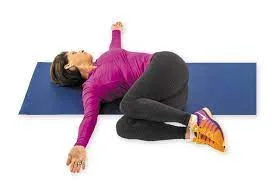
how to do it
- Lying on your back, bend your knees, and place your feet on the floor or mat.
- Gently twist your spine as you move your knee to the side, then reverse directions and move your knees to the other side.
- Hold your knees for 1 second, then repeat 20 times.
Glide of the sciatic nerve
Sciatic nerve glide, also known as Nerve Flossing, is a technique for mobilizing and stretching the nerve to minimize discomfort and increase the hip range of motion.

how to do it
- Begin by reclining on your back and resting your back on one knee.
- Straighten the supporting knee and maintain this posture while moving your ankle up and down. Hold your foot there for 3 seconds, then repeat 10 times.
- Try to do this twice a day.
Quadriceps stretch
The muscle called the quadriceps is located along the front of your leg. To extend the muscles of the quadriceps
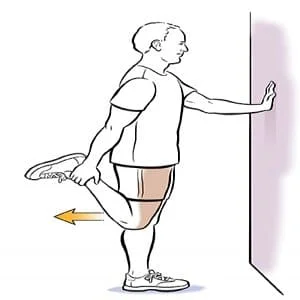
how to do it
- For support, take a position next to a wall or a piece of robust workout equipment.
- Holding onto your ankle, slowly raise and lower your heel until you feel a stretch in the front of your thigh.
- Keep your knees close together and tighten your abdominal muscles to stop your stomach from drooping outward.
- Hold on for approximately thirty seconds.
- Repeat after switching legs.
Advantage of quadriceps stretching
- Decreased tightness: Pain might arise from tight quadriceps muscles pressing on leg nerves. To release tension and reduce strain on the nerves, stretch these muscles.
- Increased blood flow to the area: Stretching can improve blood flow, which can aid in reducing inflammation and accelerating healing.
- Improved range of motion and the ability to carry out daily tasks comfortably are two benefits of increased flexibility. Your quadriceps are no different from other muscles in that they benefit from stretching. Stretching lengthens your muscles and improves blood flow, which helps reduce stiffness and soreness. Frequent quad stretches can help improve your range of motion and flexibility, which will facilitate mobility.
Heel raise

how to do it
- Hold onto anything important for support with both hands, such as a wall, table, railing, tree, or counter.
- Stand 6 to 12 inches away from a strong object such as a wall.
- Raise your heels off the floor until you feel a powerful tightness in your calf muscle. Maintain a straight spine and toes on the floor.
- Hold the position for 5 seconds.
- Slowly lower your heels.
- Rep 10 times more.
Here are some of the potential advantages of doing this exercise:
- Balance has been improved.
- better posture
- Improvements in other workouts and activities
- Calf and foot strength have improved.
- Lower body joint and tendon injury risk is reduced.
Walking
Aerobic and Flexibility:
Exercises for cardiovascular fitness, such as walking, are important to your general health and well-being.

Walking is a great way to exercise and has several advantages.
- They will assist you in controlling your weight, improving blood flow and blood sugar levels, increasing oxygen and nutrients to your legs, improving muscle strength, and promoting better sleep.
- All of these will help reduce your neuropathy.
- For those who have neuropathy, regular exercise might be challenging.
- Running, jumping rope, and burpees are a few examples of high-impact exercises that are commonly included in aerobic fitness programs.
- If neuropathy weakens your legs and feet, those demands can be too much for you to handle safely.
- Thankfully, walking is a great alternative for these activities.
- Brisk walking is still an outstanding cardio exercise, even though it’s a low-impact activity and not as difficult as the exercises we discussed above, especially if you’re walking for at least 30 minutes at a time.
Swimming
How Pools Can Benefit Patients with Neuropathic Pain:
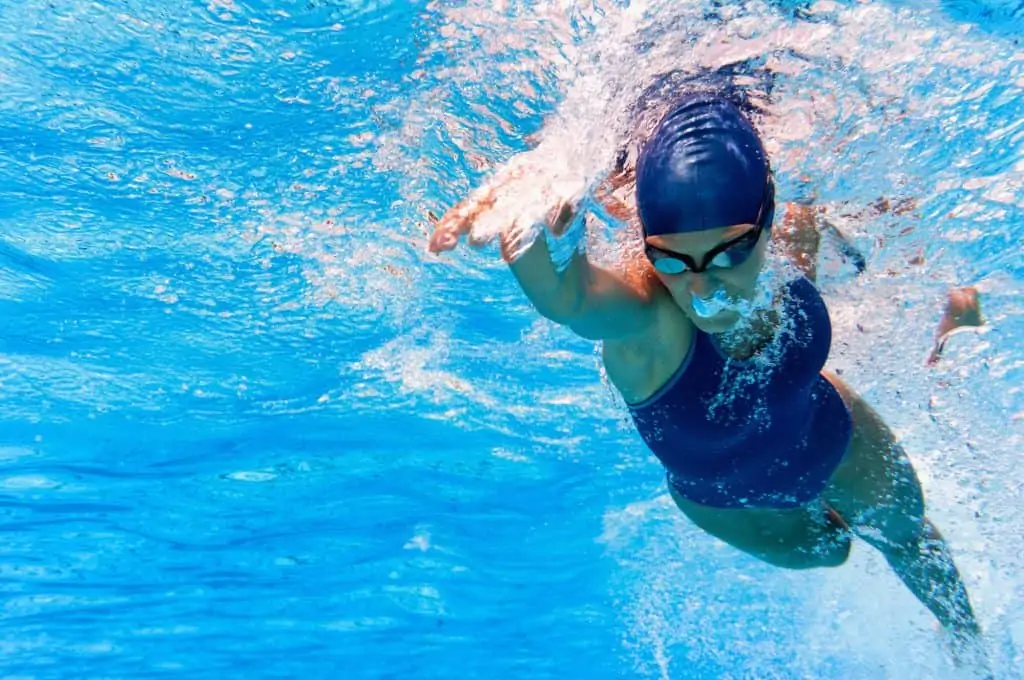
Advantages of swimming:
- The best activity for people with neuropathic pain is swimming. Particularly on the lowest part of the feet, it has less of an effect. Swimming works a variety of muscle groups without requiring excessive effort or putting too much stress on the joints or nerves. Swimming is regarded as an excellent cardiovascular exercise as well because it uses every part of the body. Additionally, it gives muscles the right tone and well-conditioned nerve tissues.
- The pool’s stable natural temperature is another advantage of swimming for neuropathic individuals. In colder climates, nerve damage is thought to occur, particularly after extended exposure. Another thing that might cause pain is cold. Therefore, when taking a bath, doctors recommend swimming at neutral temperatures for neuropathic people. For neuropathic sufferers, the water’s consistent temperature can be ideal.
- Maintain good temperature in the water
- Ask for advice on how to keep the water at a comfortable temperature. As previously indicated, the pain may get better with cold water.
- Aim for more aerobics in deep water.
- The idea is to touch the bottom of the pool with your feet with as little impact as possible. While exercising, water acts as a cushion, however, doctors advise minimizing impact to prevent pain or swelling.
Cycling
Cycling is a low-impact workout that can enhance muscular strength and balance. It can assist in improving blood flow and lessen nerve discomfort, making it an excellent option for those who have neuropathy. You can even reap some of the benefits of riding without going outside by using an adjustable balancing bike or a stationary bike.
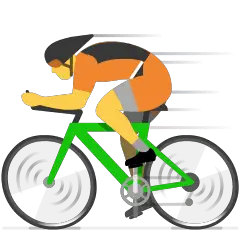
Seated-chair-squats
Strength & Stability: chair squats

How to squat on a chair:
- Facing away from your chair, take a position right in front of it. You should stand with your toes pointed straight ahead and your feet shoulder-width apart.
- Maintain a neutral spine while elevating your head and chest. As you lower your hips and bend your knees, contract your core. For added balance when lowering yourself, you might raise your arms in front of you.
- Do not get in the chair; instead, lightly tap it with your butt.
- To move your hips forward and upward and go back to the beginning posture, tighten your hamstrings and glutes.
- Do three sets of ten repetitions.
Benefits of chair squats
- If you’re new to working out, chair squats are a terrific approach to strengthen your leg muscles. As you involve your quadriceps, hamstrings, and glutes, the chair offers additional support.
- Your metabolism can be increased by doing chair squats every 20 minutes after spending a lot of time seated.
Standing Calf Raises

How to apply
- Pointing your toes straight front, take a flat standing position.
- To flex your calf muscles, raise your heels off the ground.
- After some time, gently lower yourself back to the ground. That amounts to one rep.
- Reps/sets to maximize output: Begin with two sets of ten to fifteen repetitions, with a 30- to 60-second break in between.
advantage
- The gastrocnemius and soleus, two muscles that go down the back of the lower thigh, are used by standing calf raises. Running and jumping are made possible by these muscles, which are essential for ankle flexion and extension.
- Along with the hamstrings, the gastrocnemius controls knee flexion. The soleus, on the other hand, keeps your equilibrium and raises blood flow from your leg back to your heart. The calf muscles are more prone to straining and tearing when weak.
- An easy, low-impact way to strengthen the soleus and gastrocnemius muscles is to perform calf raises. Better stability and balance, a lower chance of foot and ankle problems, and increased agility when running and jumping are all caused by strong, flexible calf muscles.
Side SLR
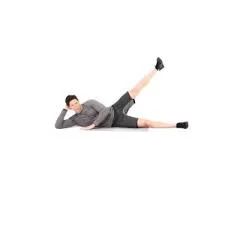
How to Perform Perfect Side Leg Raises
- For side leg lifts, begin with two or three sets of ten to fifteen repetitions. Select your sets and reps based on your ability to maintain perfect form during each set and repetition.
- Lay on your right side on an exercise mat. Put your right hand or a little towel below your head to support your neck and head. Maintain a neutral head and neck posture. Keep your chin tucked in during the exercise, as though you were using it to support an egg.
- Start with two or three sets of ten to fifteen repetitions for side leg lifts. Depending on how well you can keep your form throughout each set and repetition, choose your sets and reps.
- Lay on your right side on an exercise mat. To support your head and neck, place your right hand or a little cloth below. Maintain a neutral head and neck posture. Throughout the exercise, tuck your chin in as if you were supporting an egg with it.
Advantages of Side Leg Raises
There are many benefits to including side leg lifts in your strength-training regimen.
- Side leg lifts increase hip range of motion. When done correctly, side leg raises strengthen the muscles that lift your leg away from your torso—the hip abductor muscles, mainly the gluteus medius and minimus.
- Your core is strengthened via side leg raises. The side leg raise is a great exercise for developing functional strength and stability in your core since it targets your hip flexors, lower back muscles, and core.
- Leg lifts to the side are flexible. After getting comfortable with the basic side leg raise, think about performing a more difficult version with tension bands or ankle weights around your legs. Try the standing side leg raise variant if you’d like to use your stabilizer muscles more.
Ankle Circles
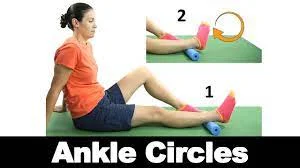
Instructions for Ankle Circles
- Maintain an upright posture, keeping your arms by your sides and your feet hip-width apart.
- Put your left toes into the ground and shift your weight to your right leg.
- With your ankles moving in little circles, begin rotating your left foot.
- Use your right foot to complete the exercise again.
Accurate Form and Breathing Cycle
To fully open up your ankle joints, start with smaller circles and gradually increase their diameter. Go back to making smaller circles if you experience any pain or discomfort. Breathe slowly and maintain a fluid, smooth gait.
Benefits of Exercise
Ankle circles are a dynamic stretching exercise that helps you release tension and release up your ankle joints. Along with increasing your flexibility, this exercise warms up your ankles, calves, and feet to help you avoid injury from exercise.
Reps And Sets
Perform the ankle circles exercise right before you begin a full-body or lower-body workout, after your warm-up. Move your feet in 30-second circles to improve joint flexibility and warm up your muscles and tendons.
Squat
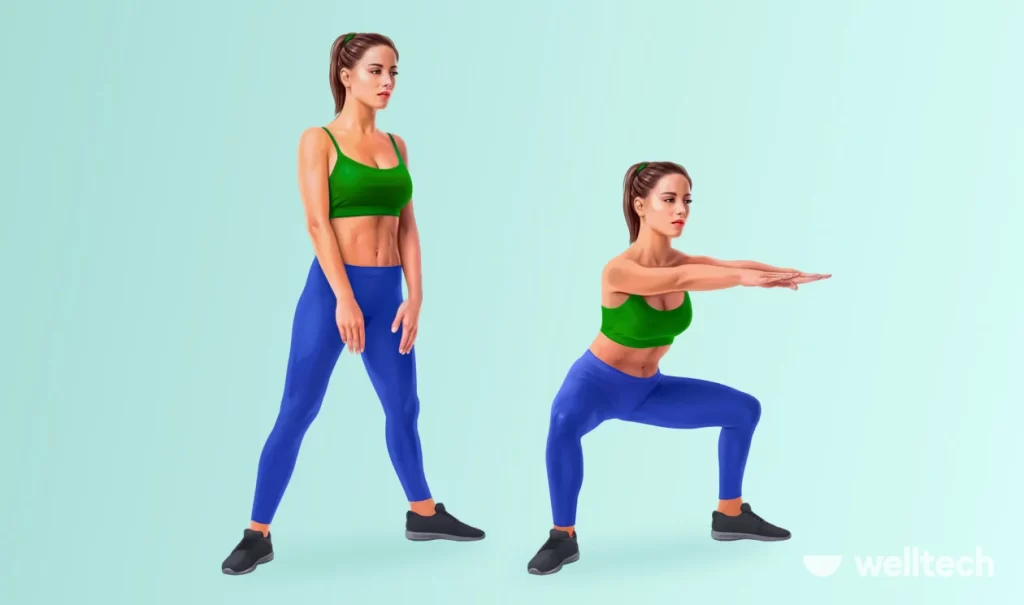
For a simple squat:
- Toes turned slightly out, start with feet somewhat wider than hip-width apart.
Engage your abdominals and shift your weight back into your heels as you push your hips back, maintaining an outward-facing chest and even pressure in your feet. - Once your heels start to rise off the ground or your torso starts to round or flex forward, lower yourself into a squat. Your form should dictate how deep you go.
- Push through your heels with your chest out and your core tight to return to your starting stance. Tighten your glutes at the summit.
- Do ten to fifteen repetitions. Work with three sets maximum.
Benefits of this exercise
Makes your core stronger
Everyday activities like turning, bending, and even standing can be made easier by having strong core muscles. Furthermore, having a strong core can help you stay balanced, relieve low back discomfort, and maintain proper posture.
lowers the possibility of harm
Gaining strength in your lower body muscles improves your ability to perform full-body motions with proper form, balance, mobility, and posture.
- burns calories
Running and cycling are two common aerobic exercises that are associated with burning calories. However, engaging in compound, high-intensity exercises like the squat can also burn a significant amount of calories. - enhances the strength of your lower body muscles
- Some of your biggest, strongest muscles are found in your lower body.
Wall Sit
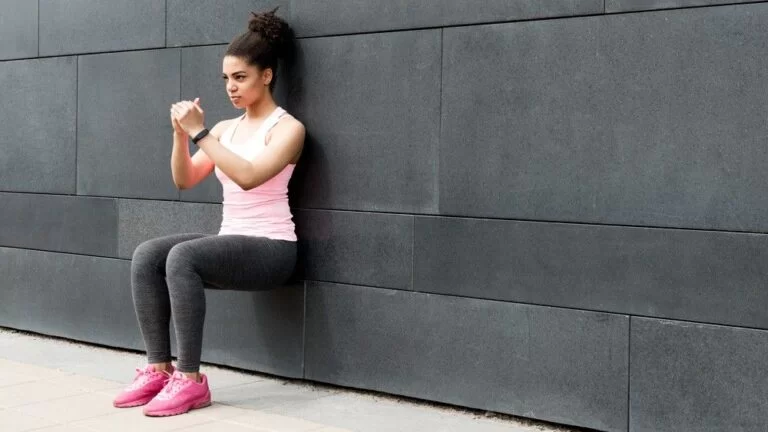
How to Do a Wall Sit
This is an activity you can do anyplace there’s a flat wall available.
- With your feet shoulder-width apart and roughly two feet away from the wall, begin with your back against the wall.
- After your thighs are parallel to the floor, carefully lower your back down the wall while contracting your abdominal muscles.
- Place your feet so that, instead of your knees being over your toes, they are directly over your ankles.
- Maintain a flat back against the wall.
- For 20 to 60 seconds, maintain the position.
- Return gently to a standing position by sliding up the wall.
- After a 30-second break, perform the exercise three times again. As you gain strength, extend your hold time by five seconds at a time.
Hip flexor stretch while kneeling
This strengthening stretch can help release any tension and improve your range of motion while strengthening your psoas and glutes.
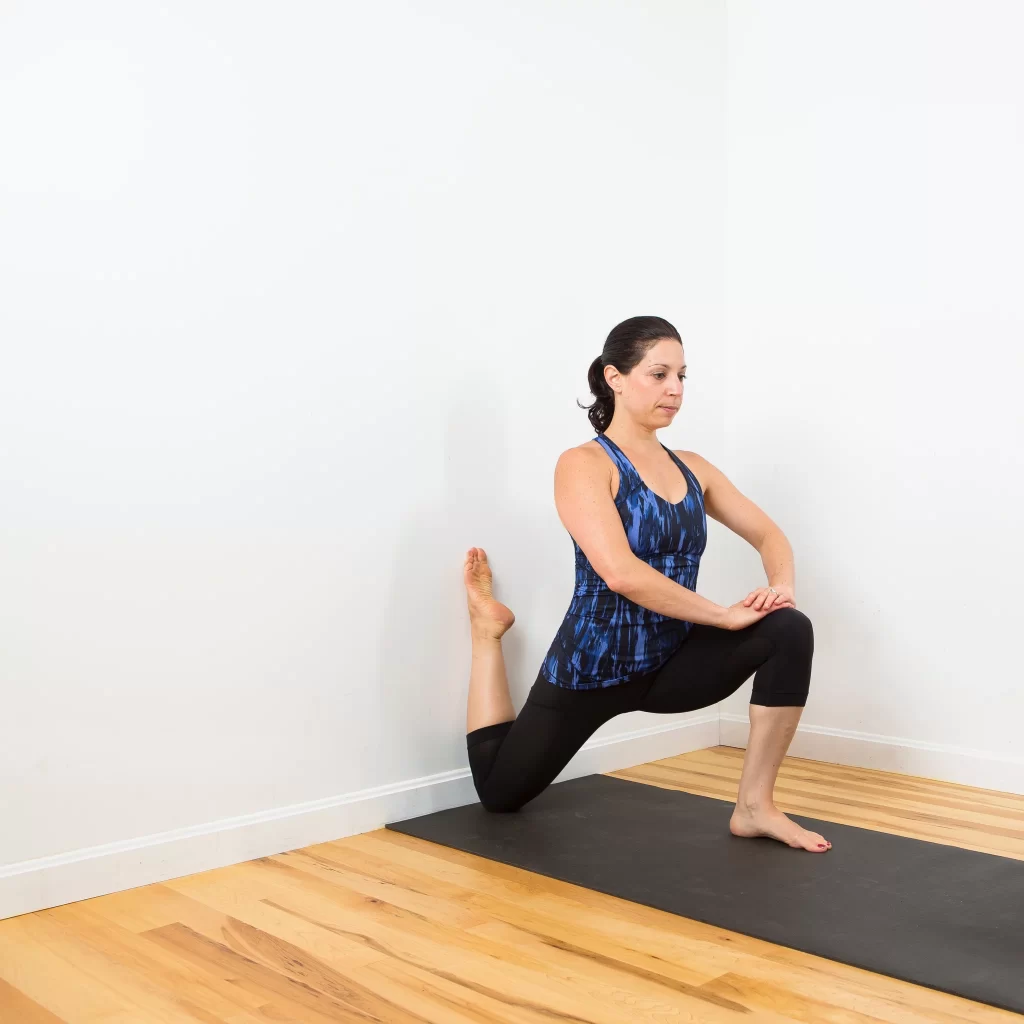
How to carry it out:
- Place your right leg in front of you while kneeling, with your thigh parallel to the floor. Place your left knee beneath your hip on the ground.
- Your hands should be on your hips.
- As you gradually move your hips forward until you feel a stretch in the front of your thigh, maintain a straight back.
- For 20 to 30 seconds, hold.
- Repeat on the other side after switching your legs.
- Repeat on each side for a total of three sets.
Yoga to Reduce Nerve Pain
Tai Chi

Tai chi is a type of exercise that lowers stress and enhances muscle strength, flexibility, and balance by combining breathing with slow, deliberate motions. It is the perfect workout for those who have nerve discomfort because of its slow, soft motions, which can be modified to suit varying degrees of coordination and athletic ability. Regular tai chi practice might lessen neuropathy symptoms and aid with balance.
Pigeon Pose
How to Do:
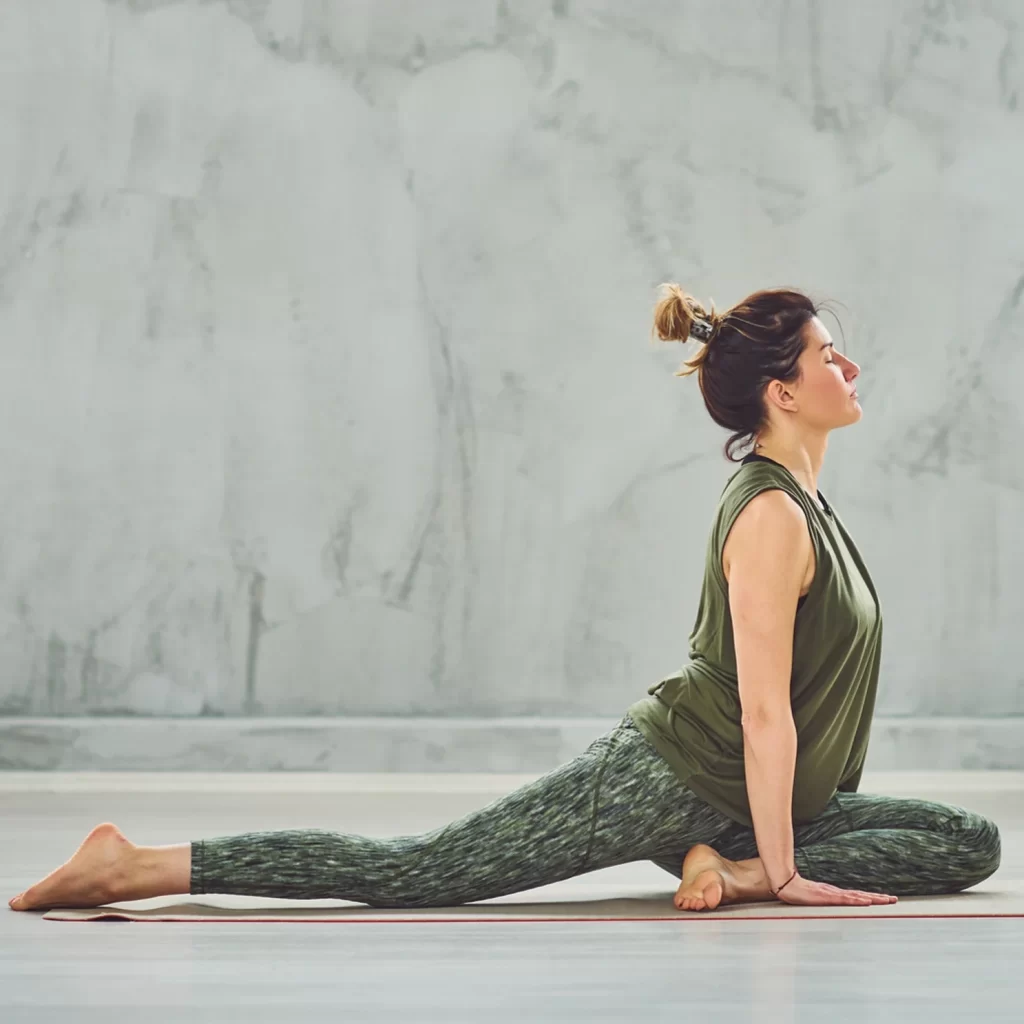
The Classic and Resting Pigeon Pose Posing Pigeons
- On a yoga mat, begin in the downward-facing dog pose. Start on all fours and place your palms down on the mat in front of you to do this pose. Raise your hips towards the sky, straighten your legs, and apply pressure to your hands and feet. Your upper body will look like an inverted V.
- Subsequently, elevate your right leg off the floor and align your right knee with your right wrist. Next, turn your right shin to face the front of your mat in a parallel position.
- Maintain a straight left leg as it touches the floor while you lower your right leg onto the mat.
- Make sure your right foot is dorsiflexed, or flexed towards the shin, and extend your right knee so that it is farther to the right than your hips. Make sure your weight is evenly distributed across both hips as you gently descend your right buttocks towards the floor. Put a folded towel behind your right buttocks if you find this too challenging.
To lengthen and straighten your spine, place both hands under your shoulders and softly press into their palms. Look directly ahead and sense the extension. You’ve reached Classic Pigeon Pose at this stage. - Reposition your shoulders so they are relaxed and slightly apart from your ears.
For five to ten slow, deep breaths, hold this position.
Continue on the opposite side.
Advantages of Bird Pose
- There are several advantages of doing Pigeon Pose regularly.
- Opening your hips is the main goal of this position, enhancing flexibility and range of motion in that joint.
- Additionally, Pigeon Pose extends your lower back and hip flexors, which are frequently tense after extended sitting. Regularly stretching these muscles can help relieve minor hip or lower back pain.
Straight-leg-hamstring-raise
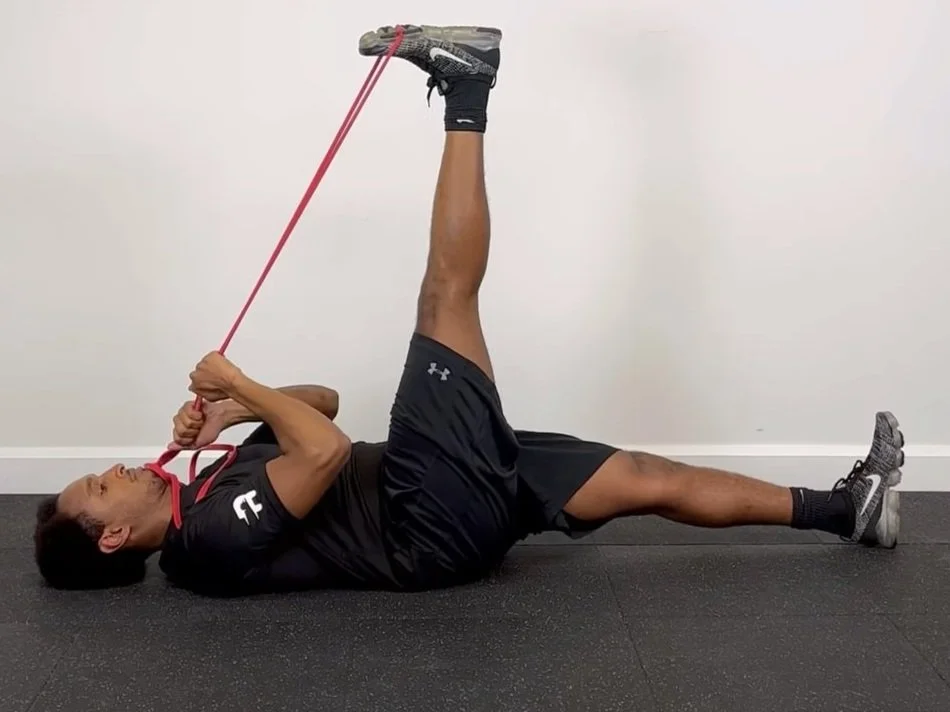
how to do it
- With your right knee bent and your foot flat on the ground, assume a flat position.
- Securely fasten the balls of your left foot with a yoga strap or resistance band.
- With your left foot raised and your knee slightly bent, raise it towards the ceiling.
- Breathe deeply while pointing your toes towards the ceiling and holding this position for up to a minute.
- Next, thrust your heel up towards the ceiling while flexing your toes to point towards your upper body. Take several deep breaths and hold.
- After eight total reps of alternating, switch legs.
Advice
- Your feet can be kept secure and comfy when doing this stretch if you use a soft yoga strap or even if you wear socks or shoes
Seated Cat-Cow
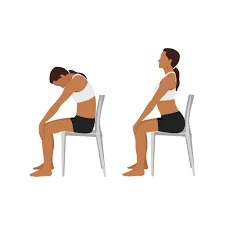
how to do it
- With your feet set on the floor, take a seat at a chair’s edge.
- Press your hands out in front of you at shoulder height during a five-second exhale.
- Let your head drop gently between your palms.
- After five seconds of breathing in, bring your hands close to your body and make a 90-degree angle with your elbows against your ribs.
- Raise your head back up as you take a breath.
- Carry out this movement eight times.
Advice
You are allowed to maintain your hands on the chair’s seat to aid in balance.
Tadasana Chair
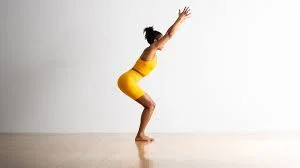
How to do:
- With your hands supporting the top of the seat for balance, take a tall stance behind a chair.
- Elevate your heels off the ground and rise onto the balls of your feet while taking a breath.
- Breathe out, bring your heels back down to the floor, then raise your foot soles towards the ceiling.
- Aim for a total of eight rounds.
- Advice
- Concentrate on lifting your toes and heels as high as is comfortable for you. Avoid pushing past any discomfort.
Savasana Supported by Legs

how to do it:
- Place a blanket or pillow under your head and lie down on the floor.
- Step up onto a chair so that your knees are resting on the seat.
- Breathe deeply for three to five seconds into your stomach.
- Hollow out your tummy by exhaling for 6 to 8 seconds.
- As you unwind in this posture, repeat this breathing rhythm.
- Advice
- Place a rolled-up towel under your lumbar spine’s curve if you have any lower back pain.
Downward-Facing Dog (Adho Mukha Svanasana)

Step by step
- With your shoulders over your wrists and your hips above your knees, begin on all fours.
- Spread your fingers and bring your hands just forward of your shoulders, pointing your middle finger forward.
- Imagine pressing through the fingertips, base of the fingers, and outside edges of your palm to form a suction cup in the center of your hand. We refer to this as Hasta Bandha.
- Roll your upper arms away from you and your forearms inward to create a spiral motion in your arms (for more specific directions, see Beginners’ advice).
- As you exhale, tuck your toes under and contract your lower abdomen to bring your navel back in line with your spine. To create an upside-down V position, press through your hands and raise your hips.
- At first, when you find length in your spine, keep your knees bent.
- Spread your collarbones as you move your shoulder blades down your spine. The bottom of the neck loosened.
- Bending and straightening your legs alternatively will help you “walk your dog” while keeping your spine long. finally lowering both heels to the ground. The floor need not be touched by them.
- Take five deep breaths.
The benefits of the Downward Dog pose
- strengthens the arms, shoulders, abdomen, legs, and upper body as a whole.
- stretches the spine, hamstrings, calves, ankles, and back of the body.
- calms your thoughts.
- stimulates the flow of blood.
- An excellent pose to relieve tension in the spine between powerful backbends and forward bends is the downward dog.
Childs Pose – Balasana
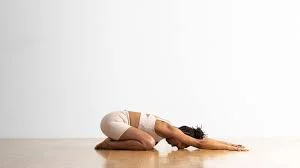
Step by step
- With your legs wider than your hips and your head pointing towards the ground, take a seat on your heels.
- You can place your hands under your forehead or extend your arms out in front of you.
- Breathe deeply into your back.
- Stay in this resting position for a few minutes or as long as thirty seconds.
- Exhale, roll up your spine vertebra by vertebra or return to a sitting position to exit.
Advantages
- stretches the lower back, thighs, hips, ankles, and knees.
- relieves fatigue
- calms the body and the mind
- Suitable at any time as a resting stance.
Reclined Pigeon Pose (Supta Kapotasana)
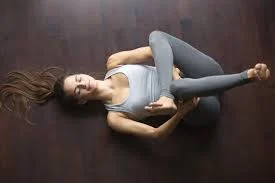
how to do it:
- Step 1 Start by lying on your back with your arms by your sides and your legs spread wide.
- Step 2: Bend your knees and plant your feet’s soles on the ground. Next, cross the right ankle over the top of the right knee to create a figure four with your legs. Raise the left foot off the ground and flex the right toes.
- Step Three
Bring the left arm to the outside of the left leg and pass the right arm through the leg opening. Using both hands, grasp the left hamstring or shin. - Step 4: Keep your head and back flat on the ground. Press the right knee away from you and draw the left shin in towards the body.
- Step 5: Release the clasp and plant both feet on the floor to exit the Reclined Pigeon Pose. On the other side, repeat.
Modification & Tips
Instead of using your hands, use a strap or a towel if your hips are tight. Instead of wrapping your hands over your shin, you might also do it around the back of your hamstring.
Seated Forward Bend – Paschimottanasana

Step by step
- From Dandasana, draw your lower abdomen up and inward, pressing your sitting bones lightly onto the floor or your prop.
- Stretch your back as you take a breath.
- Breathe out, bending forward from the hips. Refrain from bending down as much as you can while keeping your back upright.
- Start at your belly, move through your ribs, chest, and forehead, and end at your knees to maintain length in the front of your body.
- Allow your arms to fall off the surface. If your hands are extended to your feet, circle your big toes with your thumbs and first two fingers. Keep your shoulders away from your ears and your elbows bent, stretching them outward from the floor. Keep your arms straight, hold a strap with both hands, and wrap it around the soles of your feet if you are unable to support your feet.
- To extend the position further, raise your head slightly and lengthen through the front of your chest with each inhale. Try to fold farther into the posture with each exhale, keeping your spine long and your hips supported. Make sure your neck and spine are in alignment. As you slide more widely, if you are holding a strap, move your hands slowly down it. Maintain a straight arm position.
Advantages
- stretches the calves, hamstrings, and spine of the rear body.
- calms your nerves and gets you ready for meditation.
- internally stimulated organs
Benefits of Yoga Can Help nerve pain in the leg
It Can Boost Nerve Health
The Foundation for Peripheral Neuropathy states that exercise is essential to a successful neuropathy treatment plan. Yoga may even be able to directly prevent nerve injury by regulating nervous system receptors.
It Strengthens Muscle Power
Neuropathy can eventually lead to weakness and loss of muscle. A gentle, low-impact method of strengthening your muscles without making your problems worse is yoga.
It Increases Stability and Balance
Because peripheral neuropathy affects the nerves that aid in maintaining balance on your feet, it might raise your risk of fractures and falls.
That is the role of yoga. According to Soroka, doing yoga regularly might aid with stability and balance. Although yoga won’t always remove dangers immediately, it can be used as a long-term tactic to assist in increasing movement confidence and lower
It Improves Sleep
Peripheral neuropathy patients frequently have difficulty sleeping for a variety of causes, such as tension, twitching, or pain in their muscles. According to Soroka, yoga might also be able to provide some assistance in this area.
Yoga helps promote physical and mental relaxation by combining careful breathing with stretching, according to Soroka. With time, this technique can assist in lowering the chronic pain and tension that might be impairing your quality of sleep or interfering with your sleep.
Strengthens the Mind-Body Bond
You may become more conscious of your body through yoga’s ability to connect your mind and body.
Yoga can assist you in better understanding which particular movements are helpful for your body and which cause discomfort. This can help you determine which exercises or duties you feel comfortable doing off the mat and others you may want to avoid.
Risk Factors
Health issues:
- Diabetes: Unchecked elevated blood sugar levels can harm nerves in the body, particularly the legs.
- Autoimmune diseases: Rheumatoid arthritis and lupus, for example, can assault nerves, causing pain and suffering.
- Infections: Certain infections, such as shingles or Lyme disease, can affect nerves and cause pain.
- Vitamin deficits: Nerve issues may be exacerbated by deficiencies in vitamins B12 and E.
- Advanced renal disease: Neuropathy can result from this condition’s effect on nerve function.
Factors related to lifestyle:
- Alcoholism: Drinking too much alcohol can harm nerves, especially in the legs and feet.
- Smoking: Smoking may increase nerve discomfort by reducing blood flow.
- Repetitive stress: Exercises like cycling or jogging that need the legs to be repeatedly stressed can aggravate nerves and result in discomfort.
- Trauma: Leg injuries, including fractures and nerve compression, can harm nerves and result in long-term discomfort.
- Footwear: Wearing shoes that are too small or too tight can cause pain and pressure on nerves.
General risk factors:
- Age: As we get older, our nerves are more vulnerable to harm.
- Genetics: Nerve disorders are hereditarily inclined to affect some individuals.
- Family history: You may be more at risk if neuropathy runs in your family.
Prevention
One way to prevent leg nerve pain is to take proactive measures to control the several elements that lead to the development of the pain. The following are a few essential strategies that you can use:
Taking care of underlying conditions:
- Diabetes: Preventing diabetic neuropathy requires maintaining ideal blood sugar control with medicine, food, and exercise.
- Autoimmune diseases: You can reduce nerve damage by keeping to your doctor’s treatment recommendations for ailments like lupus or rheumatoid arthritis.
- Vitamin deficiencies: As directed by your healthcare provider, make sure you are getting enough vitamin B12 and E through food or supplements.
- Kidney disease: Nerve degradation can be slowed down by early identification and effective treatment of kidney disease.
Developing healthy living practices:
- Cut back on alcohol: Cutting back on alcohol or giving it up completely can greatly enhance nerve health.
- Give up smoking: Giving up smoking improves blood flow and encourages the mending of nerves.
- Keep a healthy weight: Being overweight puts additional tension on the nerves, especially in the legs.
- Exercise regularly: Walking and swimming are low-impact activities that develop muscles and enhance blood circulation, which supports nerve function.
- Put on appropriate shoes: Select shoes that fit properly, are comfortable, and have enough padding to prevent foot stress and nerve compression.
Managing risk factors:
- Prevent injuries to your legs: Wearing safety gear can reduce nerve damage when engaging in outdoor or sports-related activities.
- Maintaining appropriate posture helps to relieve pressure on the back and leg nerves.
- Control your stress: Prolonged tension might make nerve discomfort worse. Include methods of relaxation in your regimen, such as yoga or meditation.
- See your doctor regularly: Make an appointment for routine examinations to keep an eye on your health and to address any possible nerve issues early.
Extra advice
- Find out about the particular stretches and exercises that your physiotherapist or doctor recommends to manage your current nerve discomfort and stop future harm.
- In consultation with your healthcare provider, take into consideration complementary therapies such as massage therapy or acupuncture to relieve pain and support nerve health.
- Consuming a diet rich in fruits, vegetables, whole grains, lean protein, and balance ensures that the nutrients needed for nerve health are received.
Complication
Possible complications of nerve pain:
Complications could include the following, depending on the intensity and underlying cause of your nerve pain:
- Weakness in muscles: Damage to your nerves may impair your capacity to regulate your muscles, resulting in weakness and sometimes even falls.
- Skin issues: Burns, infections, and injuries can become more likely in an area where feeling is reduced.
- Foot ulcers: Severe diabetic neuropathy can result in long-lasting, painful sores on the feet that may need to be amputated.
- Mental health problems: Anxiety, despair, and trouble sleeping might result from chronic pain’s impact on your mental health.
Conclusion
Managing sciatica pain usually requires a variety of techniques, adjusting methods according to the particular origin and intensity of your discomfort. Here’s an overview of the main conclusions:
Consult with a medical professional:
Getting advice from a physician or physical therapist should always come first to receive a proper diagnosis and customized treatment regimens.
Lifestyle changes:
- Stay active: Regular exercise helps improve circulation and relieve discomfort. Cycling, swimming, and walking are all excellent choices.
- Keep your weight in check: Being overweight could strain your nerves more and make your pain worse. To achieve a healthy weight range, strive for a balanced diet and moderate activity.
- Wear supportive footwear: Selecting shoes that fit properly and soak effectively will relieve pressure on your legs and nerves.
- Apply heat or ice: To relax muscles and improve blood flow, use heat (such as a warm compress); to lessen inflammation, use ice. Select the option that most relaxes you.
- Regularly stretch: Stretches that target the calves, hamstrings, and quadriceps gently help increase the range of motion and possibly lessen discomfort.
Physical therapy and exercise:
- Strength training: Increasing the strength of the muscles surrounding your legs will help to support them and possibly lessen pain. As you focus on good form, begin slowly and lightly. Gradually increase the intensity as it is tolerated. Exercises such as lunges, calf raises, leg presses, and modified squats can be beneficial.
- Stretching: Light stretches that focus on the affected leg muscles can increase the range of motion and flexibility while also possibly lowering pain. Repeat two or three times, holding each stretch for thirty seconds.
Remember to:
- Pay attention to your body. Put an end to any painful activity and speak with your physician.
- Maintaining consistency is essential. To notice results, try to attend physical therapy and exercise sessions regularly.
- Have patience. It could take some time and effort to manage nerve discomfort, so practice patience and acknowledge little successes.
FAQs
Does pain from leg nerves subside?
Sciatica can cause excruciating pain, but most instances resolve with therapy in a few weeks. Surgery may be necessary for those with severe sciatica, significant leg weakness, or bowel or bladder abnormalities.
How can nerve pain be naturally treated?
Peripheral neuropathy: 8 natural cures
vitamins. Insufficient amounts of certain vitamins can cause peripheral neuropathy in certain situations.
Cayenne spice. Capsaicin, the chemical that gives hot peppers their fiery flavor, is present in cayenne pepper.
Give up smoking.
Warm bath. …
Exercise,
essential oils,
meditation, and so on.
The use of acupuncture
Is walking helpful for leg nerve pain?
And walking is a tried-and-true method of stimulating blood flow. For everyone, it’s the ideal low-impact aerobic workout. Your chances of minimizing your nerve pain increase with the amount of consistent activity you get.
Which seven foods might help repair nerve damage?
The seven meals listed below can aid in the battle against neuropathy and lessen arm and leg pain:
Fruits. Antioxidants included in fruits protect against nerve damage and regulate inflammation. Other sources of antioxidants include
vegetables,
whole grains,
legumes,
nuts, and
meals high in omega-3 fatty acids.
Is it possible to get rid of nerve pain?
Our team of surgical experts frequently discovers that a patient’s chronic discomfort can be reduced or even eliminated by releasing pressure on a particular nerve or separating the nerve above the site of injury. Usually, these procedures can be completed as an outpatient procedure with relatively minor incisions.
Is it possible for nerve pain to heal itself?
Damaged nerves can recover and regain function with the aid of Schwann cells. Damaged nerves can regenerate at a pace of one millimeter or one inch each day on average. If there is a large amount of scar tissue or a space between the severed nerve ends, surgery is required.
How can I speed up the healing of my nerves?
Exercise is vitally necessary during rehabilitation, not just to assist your muscles in restoring their function but also to improve blood flow throughout your body. Thus, nerve repair is accelerated. Similarly, inaction hinders advancement. The more you use your muscles, even if you don’t want to overdo it, the better.
Can Eggs relieve nerve pain?
People with neuropathy frequently have reduced B12 levels. Eating foods high in B12, such as eggs, milk, or cheese, is important. Please do not hesitate to discuss B12 supplements with a doctor if you need further help. A doctor might advise a blood test to measure B12 levels to make a sound diagnosis.
What is the quickest technique to treat leg nerve pain?
Heat and ice packs
The combination of heat and cold encourages new blood flow to the area, which could lessen discomfort. To help decrease inflammation, apply an ice pack to the affected region for about 15 minutes at a time three times a day.
References
- Schaefer, A. (2018, December 7). 5 Natural Remedies for MS Nerve Pain in the Legs and Feet. Healthline. https://www.healthline.com/health/multiple-sclerosis/nerve-pain-legs-feet#At-home-solutions
- Center, D. S. A. S. (2022, October 24). How to Relieve Nerve Pain in Your Leg | Desert Spine. Phoenix Spine Surgeons. https://phoenixspinesurgeon.com/the-step-by-step-guide-to-relieve-nerve-pain-in-your-leg/
- How to Relieve Nerve Pain in Your Legs. (n.d.). https://www.excelsiainjurycare.com/blog/relieve-nerve-pain-in-your-legs
- Cooper, G. (n.d.). Nerve Pain in the Leg. Spine-health. https://www.spine-health.com/conditions/leg-pain/nerve-pain-leg
- Galic, B. (2018, January 30). Yoga for Peripheral Neuropathy: Best Exercises, Benefits, Tips. LIVESTRONG.COM. https://www.livestrong.com/article/342259-yoga-for-peripheral-neuropathy/
- Seated Forward Bend – Ekhart Yoga. (2020, November 6). Ekhart Yoga. https://www.ekhartyoga.com/resources/yoga-poses/seated-forward-bend
- GoodRx – Error. (n.d.). https://www.goodrx.com/well-being/movement-exercise/quad-stretches
- Montijo, S. (2022, January 26). Oh, the Nerve! 5 Exercises to Ease Meralgia Paresthetica Pain. Greatist. https://greatist.com/health/meralgia-paresthetica-exercises
- Trigg, L. (2023, November 10). Physio for Nerve Pain | Nerve Pain | Integrity Physiotherapy. Integrity Physio. https://www.integrityphysio.com.au/blog/physio-for-nerve-pain/

